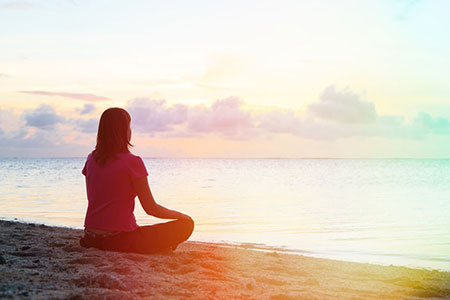Meditation Is Easier Than You Think!
 No doubt you’ve heard of the many benefits of meditation, both physical and spiritual. But how does one start a meditation practice? It doesn’t have to be intimidating. According to the Zen master and teacher, Shunryu Suzuki, approaching meditation with a beginner’s mindset is actually ideal.
No doubt you’ve heard of the many benefits of meditation, both physical and spiritual. But how does one start a meditation practice? It doesn’t have to be intimidating. According to the Zen master and teacher, Shunryu Suzuki, approaching meditation with a beginner’s mindset is actually ideal.
It’s important to clear up a common misperception about meditation. Meditation is not simply ‘thinking of nothing.’ Rather it is a spiritual process in which we learn to center, breathe, and achieve clarity.
Meditation is practiced by cultures all over the world and does not have to be associated with a specific spiritual tradition or religious belief system. It also does not have to involve sitting passively with a ‘blank mind.’ Rather it can be anything from coloring mandalas, to a walking in nature.
So, how does one begin, if you’re new to the practice? Consider the goals you wish to achieve with meditation: stress reduction, taming your thoughts, physical relief from pain, spiritual growth? Tailor your practice to build toward your personal goals. Remember, it’s a journey and not a destination.
Keeping a meditation journal, as you go along, can be very helpful. The most important thing is consistency. Make meditation a part of your daily routine, and ideally at the same time each day.
Once you have the basics in place, it’s time to begin. Choose a pose or stance which is comfortable, and a space which is calming, private and quiet. If playing comforting music or lighting candles, or incense, relaxes you, then do that!
The more regularly and the more deeply you meditate, the sooner you will find yourself acting always from a center of peace ~ J. Donald Walters
Start out slowly, perhaps five minutes at a time. The first thing you’ll want to do is simply breathe deeply, focusing on each breath. In a busy modern world we have a tendency to forget to breathe properly. Count the breaths, and, if you like, imagine positivity flowing in and negativity flowing out.
As you begin to do this, some people find it helpful to engage in creative imagery, or simply to let their minds wander. It will feel strange at first, since we are constantly bombarded with incoming stimuli. Meditation acts like a sieve to sort through the waters of thoughts, leaving only the clear water. After you start, you’ll feel some of the mental fog start to lift.
Instead of ‘becoming one with the universe,’ the main objective of meditation is much more practical earthbound for most people. Meditation is about increasing one’s self-awareness and grounding yourself energetically. Many of us are ruled by our racing thoughts and negative self-talk, which can easily spiral out of control. Meditation acts as a mental lightning rod to deflect all that energy elsewhere, so that it doesn’t harm us.
The goal of meditation is not to get rid of thoughts or emotions. The goal is to become more aware of your thoughts and emotions and learn how to move through them without getting stuck ~ Dr. P. Goldin
If you feel nervous or self-conscious about starting meditation, don’t worry. There’s no such thing as failure in meditating. There are also many online tutorials and guided meditation apps available these days. If you find it challenging to start on your own, see if you can find one that might work for you.
If you’re the kind of person who doesn’t like sitting still for long periods of time, take up a physical or recreational activity that can also serve as a form of meditation, such as walking or arts and crafts.
No matter which style of meditation you choose, remember that it’s called a spiritual ‘practice’ for a reason. Everyday meditation is not about achieving perfection or supreme enlightenment, but simply about bettering yourself and taming your thoughts.
|
|

Leave a Reply